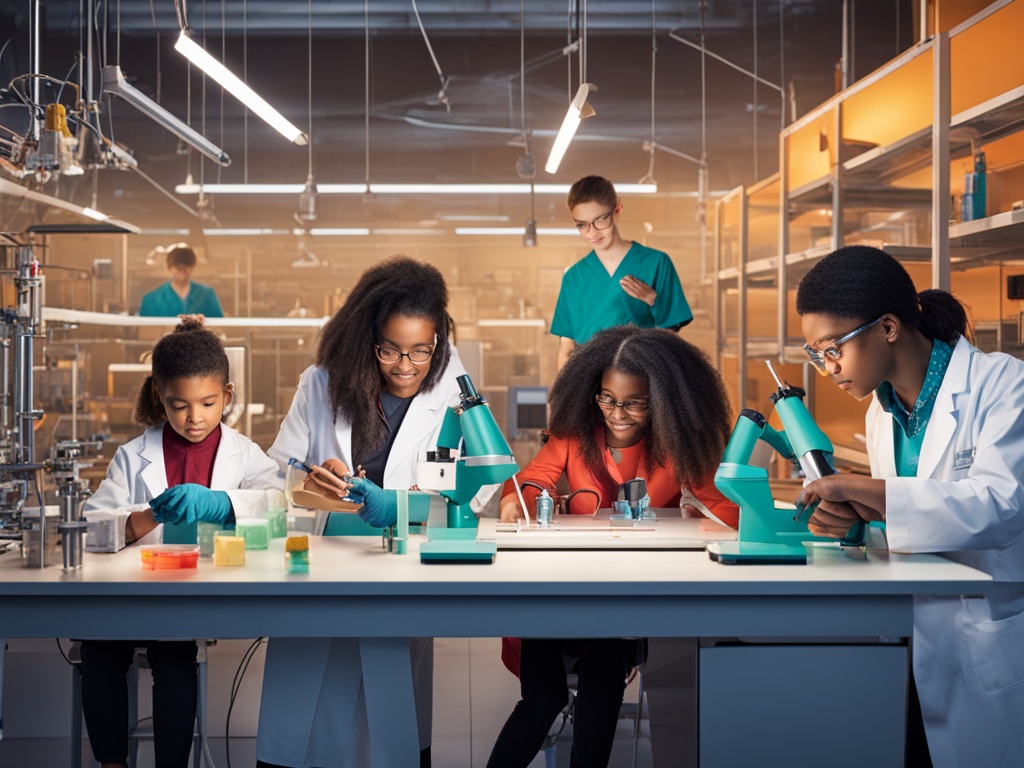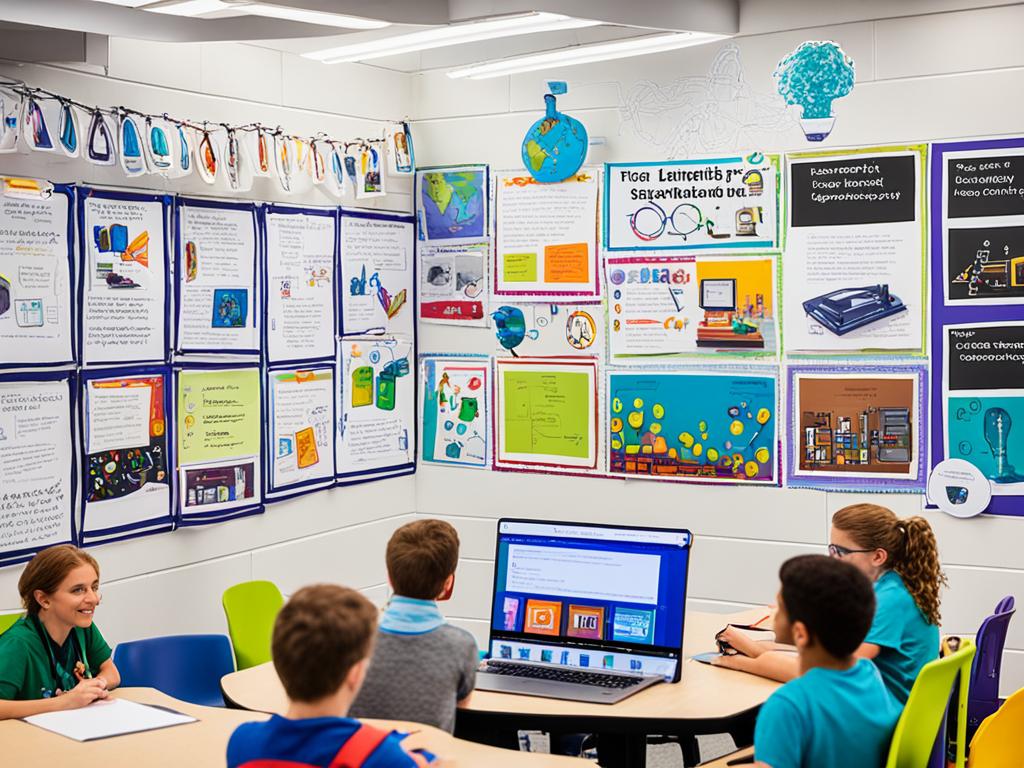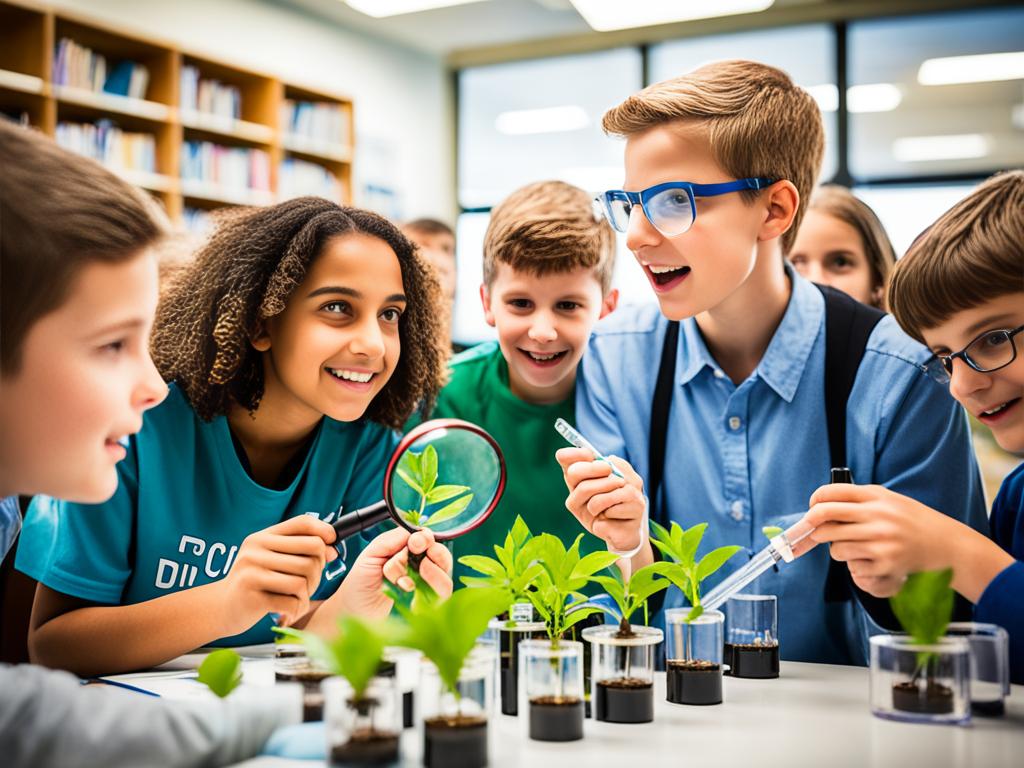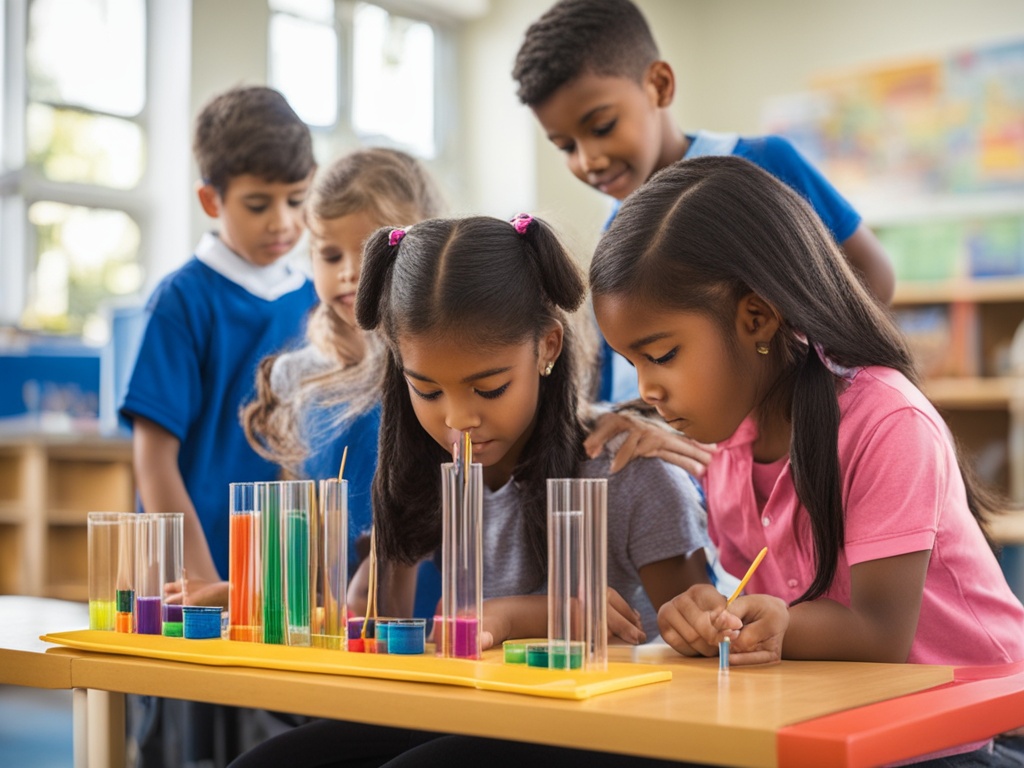This guide is packed with top-tier strategies and insights for educators. It’s designed to1 spark scientific curiosity, boost innovation, and empower the scientists of tomorrow. It pulls from expert advice and real stories to craft a path for inspiring young thinkers.
Teachers will find golden tips on spotting and supporting talented students. They’ll also learn about setting up mentor programs and fun, hands-on activities. This guide shines a light on the key role of science literacy. It shows how to mix STEM into education in a meaningful way. And it shares tips for making science fair projects a hit.
By applying the advice in this ultimate resource, educators worldwide can lead students to reach their highest potential.
Key Takeaways
- Discover excellent ways to grow scientific curiosity and encourage new ideas in the classroom.
- Learn how to find and help gifted students, and give them chances to learn from mentors.
- See why it’s important to boost science knowledge and include STEM studies for student success.
- Enjoy getting young minds excited through interactive learning and fun science fair activities.
- Make the most of your teaching by following the comprehensive advice and strategies in this guide.
Nurturing Scientific Curiosity in Young Minds
Getting kids excited about science is the key to the future. Teachers have a big role in this. They should encourage kids to ask questions and figure things out on their own. This sparks a love for learning that lasts a lifetime.
Fostering a Love for Exploration and Inquiry
Educators can make science fun by setting up activities where kids can ask why and how. This helps bring out their natural curiosity. By using fun lessons and letting kids do experiments, they make learning an adventure.23
Encouraging Hands-on Learning Experiences
Doing things with their hands helps students get what science is all about. It makes them understand the ideas better. By letting them do projects and be hands-on, educators make learning real and exciting.
Teachers can light the spark for science by giving students the chance to explore and create. This plants the passion for discovery. And this is how the next generation of scientists will start their amazing journey.2
Promoting Science Literacy: A Foundation for Innovation
It’s vital that we help young people love and understand science. This is key to creating the next group of innovators and solvers.4 The Wisconsin Initiative for Science Literacy (WISL) highlights how knowing about science is good for society. It also helps interest people in careers like research, teaching, and public work.4 Giving students the ability to think critically and solve problems is really important for the future.
Developing Critical Thinking and Problem-Solving Skills
People who know about science make better choices and can spot fake news. They also help make our governments work better.4 Teachers are key in helping students think critically about issues. They teach how to understand science and the methods scientists use to find answers.4 This helps students learn to ask good questions, check facts, and find new solutions to tough problems.
Integrating STEM Education into the Curriculum
Adding STEM (Science, Technology, Engineering, and Mathematics) to lessons helps create well-informed individuals.5 This way of teaching not only makes science clearer but also helps develop skills needed in today’s world.5 Using topics that mix different subjects makes learning more interesting and helps students do well in jobs connected to science.
By focusing on science, teachers can make students better at solving problems, thinking clearly, and always wanting to learn more.45 This strong science start is what today’s young people need. They will be ready to face big problems and make progress in many study areas.
Empowering Future Scientists
Our goal is simple: find and uplift talented students on their journey in science. We guide them towards a future where they can make groundbreaking discoveries.6 High school students are diving into real research, getting their work published in science journals.6 Studies show this involvement makes science feel more personal to them.6
Identifying and Supporting Gifted Students
First, we spot talented students and help them prepare for a career in science. We use special methods to make sure they reach their peak in STEM areas.6 Teaching them how to read and write like scientists, and about professional science work, is key. It’s part of our mission to find these skills in gifted students.
Providing Mentorship and Guidance
Mentorship is crucial, where students learn from top-level scientists and researchers.6 Mentors vary on how they see publishing student work, but they agree on letting students explore on their own.6 Giving students one-on-one help and chances to grow is how we break down barriers and set them up for success in STEM.

Science Fair Projects: A Gateway to Discovery
Science fair projects open the door to discovery. They spark curiosity and offer hands-on learning opportunities. These experiences encourage students to think critically and solve problems.7
Teachers guide students using the scientific method. This helps students love research and prepare for a career in science. Entering a science fair boosts their knowledge, allows for learning new things, and may lead to awards.8
Science fairs expose students to different scientific ideas. They cover everything from the basics of physics like gravity, motion, and energy to innovative engineering projects. This fosters a love for problem-solving and creativity.7 It also prepares the future generation of scientists and innovators.8
| Key Benefits of Science Fair Projects | Strategies for Effective Implementation |
|---|---|
|
|
Educators use science fair projects to start students on a journey of discovery. They inspire kids to love science, learn important skills, and become future scientists and innovators.78
Building a Culture of Innovation in the Classroom
Fostering innovation in the classroom is crucial for upcoming scientists and inventors. We aim to inspire them by creating an environment that boosts creativity, teamwork, and a growth mindset. These skills are vital for success in science, technology, engineering, and math fields.
Fostering Creativity and Collaboration
Giving students chances to experiment and solve problems together is essential for an innovative culture.9 New teaching techniques, focusing on engaging students, can unleash their creativity and ability to work together.9 When students share ideas and accept different viewpoints, they learn to solve problems creatively, a key for innovation.
Embracing Failure as a Learning Opportunity
In a forward-thinking class, failure is part of the learning process, not a step back.9 Unlike old methods that stress memorizing facts and getting high scores, today we focus on practical learning.9 Encouraging students to take chances and learn from mistakes builds their toughness and readiness for the future.
Freedom to explore, work with others, and learn from failure helps students grow.10 They will develop a mindset and skills that are crucial for success in science and innovation.10 This is how we prepare the next leaders in overcoming cutting-edge challenges, adapting to new tech, and leading in different fields.

Inspiring the Next Generation of Researchers
Making young people love science and research is key to creating future innovators. Teachers are vital in showing students how science affects the world. They connect lessons to real life, making science practical.11 By working with groups like Learning Undefeated, teachers can influence over 1.5 million students and 25,000 teachers in the U.S. This motivates them to think about choosing STEM jobs.11
Connecting Students with Real-World Applications
Teachers spark an interest in research by showing how science changes lives.11 For example, the UF Health Cancer Center holds a symposium for high schoolers on cancer research. The University of Maryland’s CURE program helps underprivileged students aim for success in STEM.11 Through these connections, educators show how impactful research can be. They encourage students to follow a path in research.
Highlighting Role Models and Success Stories
Telling about successful role models can inspire future researchers.11 In Maryland, the Emerging Leaders in STEM Program connects girls with STEM professionals. This helps the girls picture themselves in similar jobs.11 Likewise, Sweden’s STEM effort gives students in grades 4-9 chances to visit schools and do summer research. It also offers individual help. This encourages a strong interest in natural sciences.11 By sharing stories of scientists from various backgrounds, educators help students see they too can achieve in science.
To inspire future researchers, we need to use many strategies. We should make science connect to everyday life, build a spirit of curiosity, and show various paths to success in STEM.12 Using videos, interactive tools, and stories, teachers can make learning fun. This sparks a lasting interest in science and research among students.12
Youth Mentorship: Unlocking Potential
Empowering future scientists begins with nurturing their passion. Educators are key in creating mentoring programs. These programs connect students with science, research, and tech professionals.13
Establishing Mentoring Programs
Through mentorship, educators can connect students with valuable guidance. They also get to see science in action. Real-world experiences help students imagine their future as innovators.14
Educators work with local hospitals and professionals to offer unique learning opportunities. This includes Youth Medical Mentorship Summits and hands-on activities. Such initiatives prepare students for STEM careers by boosting confidence and skills.13
Addressing Challenges and Barriers
Starting mentoring programs can face obstacles. Educators need to tackle these challenges head-on. This can mean working with schools to hold events like science fairs and summer camps.13
By building a strong mentorship culture, educators help students break through barriers. This approach equips students for success in STEM. It boosts their skills, confidence, and networks, setting them up for bright futures.14

STEM Education: A Path to Future Success
In today’s world, STEM education is key for future success. The United States needs more people in science, tech, engineering, and math. Educators must teach students the skills to do well in today’s job market.
Integrating Technology and Engineering Principles
Bringing tech and engineering into the classroom helps students understand these topics better. Through hands-on experiences and new teaching ways, teachers can make their students tech-savvy. They learn to solve real-world problems using engineering principles.15
Preparing Students for Careers in STEM Fields
More and more jobs in STEM are opening up. It’s expected over a million new STEM jobs will be available by 203015. However, most of the STEM careers needed by 2030 haven’t even been made yet.15
STEM fields like robotics, computer research, and engineering are becoming very important15. STEM education also helps kids get better at thinking, creating, working together, solving problems, and talking to others. This makes them well-prepared to succeed in science-related careers.15 By teaching a wide-reaching STEM curriculum, educators help students become great problem solvers, creative thinkers, and people who can keep on learning throughout their lives.
https://www.youtube.com/watch?v=RQmM7D4gGh4
Hands-on Learning: Engaging Young Minds
Hands-on learning is key to making future scientists. Through fun experiments, teachers awaken curiosity in students. They get to understand science better this way.16
Modern Biology, Inc. stands out with its great kits for interactive learning.16
Designing Interactive Experiments and Activities
Doing physical experiments brings science to life. It helps students grasp complex topics. A blog post highlights the perks of working together on experiments.16 This includes building skills like critical thinking and teamwork.16 It’s also a chance to learn to communicate and compromise.16 Trying out experiments boosts confidence and a “can do” attitude, says the blog.16 Experiments are a big deal in learning, as they lay the foundation for a life full of discovery.16
Creating Immersive Learning Environments
Experiments aren’t the only engaging part of science. Creating cool spaces like labs and outdoor areas also matters.17 Today, tech offers virtual labs, making learning even more exciting.17 It breaks down barriers, allowing mentors to help from anywhere.17 High schoolers get to think deeply thanks to special research chances.17 Then, they get to lead their own science projects, boosting creativity and problem-solving.17 STEM learning is great at kindling a love for research in young people.17
So, using these cool methods helps kids love science. STEM is becoming more common in schools thanks to its benefits.18 It helps kids think, create, and work together.18 They learn skills useful in fields like engineering, healthcare, and more.18 These activities make science fun and develop important thinking and problem-solving skills.18

Science Outreach: Connecting with the Community
We, as educators, have a huge influence. We can inspire the next generation of scientists. By connecting what’s taught in the classroom with the world outside, we can do this.19 This connection is even more important for minority scientists. It lets them speak up against disparities, push for diversity, and empower their communities.19 Making strong ties with the local community helps spread the word about science education. It also creates a supportive environment for those dreaming of a career in science.
Organizing Science Fairs and Exhibitions
Organizing science fairs and exhibitions is a great way to reach out. It brings science to life through hands-on experiences and personal stories. This can make learning more effective for students and interest the general public in science.19 Showing off the work and creativity of our students can make the whole community proud. It also makes them value the search for knowledge even more.
Collaborating with Local Businesses and Organizations
Working with local businesses and organizations is key. It offers students chances to use what they learn in real situations. It also opens doors to the latest resources and mentorship.20 Many important agencies, like the Department of Defense and NASA, have programs to get the public involved in science. These connections help create a strong support network. It encourages students to chase their scientific dreams.
The Native Scientist program is a good example of this. It connects with migrant communities, getting over 1,200 students a year interested in science.21 Their Native Schools program teaches science through various languages. It promotes fairness, diversity, and inclusivity.21
Science outreach and community engagement are powerful tools. They help us guide the next wave of scientists. They also empower those who might not usually get the chance. Together, we can foster a spirit of innovation that goes beyond the classroom walls.
Empowering Educators: Professional Development Opportunities
Empowering educators is vital for the future of science and innovation. It’s key to offer them the resources, training, and support needed. This helps them guide students towards exploring the wonders of science and technology.22
Accessing Resources and Training
Teachers are at the forefront of inspiring tomorrow’s scientists. They must have access to opportunities for professional growth. This approach ensures they are well-equipped to encourage their students. Together, educators can create environments that spark curiosity and innovation among pupils.23
By joining training sessions and practical workshops, educators can learn new ways of teaching. They incorporate the latest tech tools and creative approaches to teaching science and math. This not only benefits the teachers but also boosts student success. When teachers are constantly improving, more students excel in their studies.22
Building a Supportive Network
Support for educators goes beyond training. It includes connecting with other teachers. By sharing tips and advice with peers, teachers find new ways to have a positive impact. It’s about working together towards a common goal of educational excellence.22
This network acts as a lifeline for educators, offering them support and fresh perspectives. Together, they overcome teaching hurdles and deliver high-quality education in science and technology. By supporting each other, they remain inspired and inspire the next wave of scientists and creators.23
| Key Insights | Statistics |
|---|---|
| 74% of teachers reported that PLTW Core Training made them more effective as a teacher. | 23 |
| 68% of teachers reported that PLTW Core Training had more of an impact on their teaching practice than other professional development. | 23 |
| 67% of teachers felt PLTW made them more satisfied with their careers. | 23 |
| 94% of teachers in the United States use technology in the classroom, with 52% using interactive whiteboards. | 22 |
| Effective professional development positively impacts student outcomes, with students in classrooms led by teachers who engage in professional development showing higher achievement levels. | 22 |
| Lack of resources is a significant barrier to effective teaching and student achievement. | 22 |
Conclusion
As we come to the end of our guide, let’s remember how much educators matter. They help the young minds who will become future scientists. Nurturing scientific curiosity, building science literacy, and giving students the right resources and support are key.24
Using the tips in this guide, teachers can help make future researchers and pioneers. It all starts with a deep passion for learning, exploring, and discovering. This is the way to support science’s future and encourage new ideas.
As you keep moving forward, we urge you to grab the chances for growth and learning. Use the tools and ideas we shared to touch your students’ lives. Let’s work together in making a world where science thrives and the future looks bright.2526
FAQ
What are the key strategies for nurturing scientific curiosity in young minds?
How can educators promote science literacy and develop critical thinking skills in students?
What are the best practices for empowering future scientists?
How can science fair projects benefit students and inspire future scientists?
What strategies can educators use to build a culture of innovation in the classroom?
How can educators inspire the next generation of researchers?
What are the benefits of youth mentorship in empowering future scientists?
How can educators integrate STEM education and prepare students for careers in STEM fields?
What are the benefits of hands-on learning in engaging young minds and fostering a deeper understanding of scientific concepts?
How can educators leverage science outreach and community engagement to empower future scientists?
What professional development opportunities are available to empower educators in nurturing future scientists?
Source Links
- https://www.fetc.org/program
- https://www.twistedscience.com.au/blog/nurturing-the-roots-of-stem-literacy-the-power-of-creativity-curiosity-and-connectedness-in-our-communities/
- https://www.teachfornepal.org/bulletin/2023/02/15/embracing-the-marvels-of-science-unleashing-curiosity-and-empowering-young-minds/
- http://www.scifun.org/wisl/wisl.html
- https://www.ncbi.nlm.nih.gov/pmc/articles/PMC8035063/
- https://www.biorxiv.org/content/10.1101/2024.03.15.585231v1
- https://steamboatstudio.com/blog/interesting-science-topics-for-children-intro-guide/
- https://www.apa.org/education/k12/science-fair-manual.pdf
- https://piogroup.net/blog/20-innovative-teaching-methods-with-examples-how-to-implement-in-education-process
- https://steamspirations.com/26123-2/
- https://www.astrazeneca.com/r-d/our-approach/stem-at-astrazeneca.html
- https://www.linkedin.com/advice/0/what-best-ways-inspire-empower-next-generation-scientists-jirdc
- https://youthmedicalmentorship.org/
- https://outlaw.vn/the-blueprint-for-brilliance-developing-skills-for-future-scientists/
- https://www.linkedin.com/pulse/using-stem-shape-future-scientists-worlded
- https://modernbio.com/blog/what-are-the-benefits-of-doing-experiments-with-students/
- https://baominhmart.vn/empowering-young-minds-the-role-of-technology-in-science-education/
- https://amazingcoffee.vn/elevating-science-education-innovative-strategies-for-engaging-young-minds.html
- https://medium.com/stem-and-culture-chronicle/contributing-to-your-community-through-science-8748a54b696e
- https://www.asbmb.org/education/science-outreach/outreach-resources
- https://www.nativescientists.org/single-post/native-scientist-publication-trends-voices
- https://medium.com/@khanfirdosh/empowering-educators-the-key-to-a-transformative-future-for-youth-ac5dd915be29
- https://www.edsurge.com/news/2023-09-25-empowering-teachers-and-inspiring-students-for-a-stem-driven-future
- https://www.biorxiv.org/content/10.1101/2024.03.15.585231v1.full
- https://medium.com/mostly-about-science-mas/empowering-future-scientists-the-power-of-great-lab-supervision-e65623fba83e
- https://www.sciencepolicyjournal.org/article_1038126_jspg240104.html
